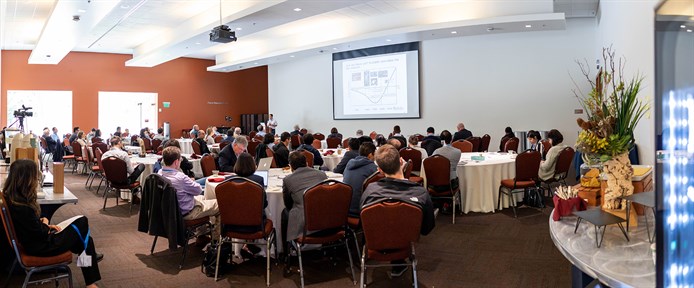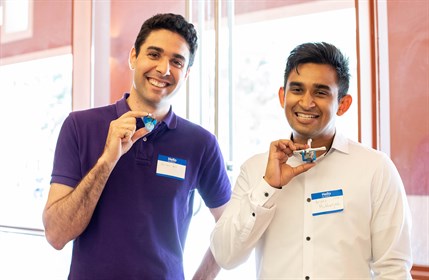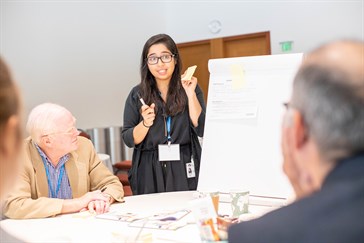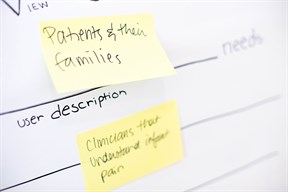Surgical Innovations Hosts Symposium Uniting Partners Around Children's Health
On May 17, the Second Annual UCSF Engineering for Children’s Health Symposium was held at Mission Bay Conference Center. Over one hundred clinicians, engineers, scientists, administrators, industry professionals, and government partners gathered to discuss groundbreaking research and developing technologies in pediatric medicine.

The event commenced with opening remarks by Hanmin Lee, MD, Surgeon-in-Chief of the UCSF Benioff Children’s Hospitals and Professor and Chief of the UCSF Division of Pediatric Surgery, along with Bertram Lubin, MD, Associate Dean of Children’s Health at UCSF, which highlighted the large unmet need for pediatric medical devices, due to the lack of economic incentives for new technology development for small markets. Research talks by faculty from UCSF and UC Berkeley along with industry partners covered three main themes: fetal therapy and diagnostic technologies, device solutions for kids, and AR/VR and emerging technologies.

Pediatric surgeon Tippi MacKenzie, MD, kicked off the research presentations with her work on maternal-fetal precision medicine, specifically the effect of fetal T cell tolerance of maternal antigens on preterm labor. Dr. MacKenzie, who is currently leading the world’s first clinical trial of in utero stem cell transplantation, also discussed advancements in the field of fetal therapy, which began with the first open fetal surgery performed by Dr. Michael Harrison at UCSF and evolved towards innovative molecular therapies being studied in her lab. Aaron Kornblith, MD, Assistant Clinical Professor of Emergency Medicine and Pediatrics at UCSF, and Adam Rao, MD/PhD candidate in the Medical Scientist Training Program at UCSF, presented Rao’s Tabla device – a digital tool for detecting pediatric asthma, one of the most common chronic pediatric diseases in the United States. The handheld device detects acoustic sound waves which are then analyzed by a machine-learning algorithm to assess disease severity.
Additional highlights included talks by Tejal Desai, PhD, Professor and Chair of Bioengineering and Therapeutic Sciences at UCSF, on nanoscale materials for therapeutic drug delivery, and Homayoon Kazerooni, PhD, Professor of Mechanical Engineering at UC Berkeley, on exoskeletons for pediatric mobility disorders. The presenters’ wide range of disciplines, from clinical to engineering specialties, exemplified the pressing need for collaboration in the field of pediatric medicine.

Throughout the day, attendees interacted with demos of novel pediatric devices under development, including a tracheostomy alarm (Asphyxi-Alert), enteral feeding system (Gravitas Medical), breastfeeding appliance for infants with cleft palate, and ionic-dilution technology for vascular catheter navigation (Piccolo Medical). Adam Rao’s Tabla, Dr. Kazerooni’s SuitX, virtual reality software KindVR, and the UCSF Pediatric Device Consortium returned for the second year with updates on their devices and ongoing clinical trials. The program also included a human-centered design workshop facilitated by Amanda Sammann, MD, Assistant Professor of Surgery and Executive Director of The Better Lab. The hands-on session allowed participants to reimagine the pediatric patient experience through group brainstorming activities.
In the afternoon, Dr. Lee moderated a panel discussion on incentivizing pediatric device development between leading industry, government, and academic experts. Panelists shared their challenges and lessons learned as pediatric device developers and discussed the need for cross-sector collaboraiton and incentive strategies to get more pediatric devices to the market faster. The symposium concluded with a keynote presentation by Vasum Peiris, MD, MPH, Chief Medical Officer for Pediatrics and Special Populations at FDA’s Center for Devices and Radiological Health, who shared the FDA’s priorities and initiatives for improving pediatric public health and resources available to device innovators.
